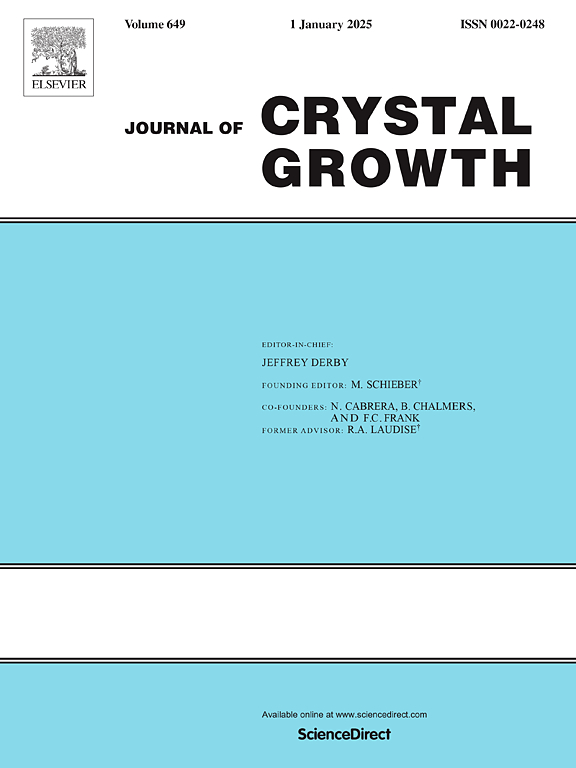Effects of crystal and melt transparency on twisting of β-Ga2O3 crystals grown by the Czochralski method
IF 2
4区 材料科学
Q3 CRYSTALLOGRAPHY
引用次数: 0
Abstract
The twisting of oxide crystals during their growth process is a major problem that has limited their wider application. We previously conducted three-dimensional analyses that indicated the twisting of beta gallium oxide crystals may be affected by their degree of transparency. In this study, we conducted numerical simulations to study the effects of internal radiation in beta gallium oxide crystals and melts on heat transfer during the Czochralski method. The temperature and velocity distributions in the crystal and melt and the shape of the interface between the crystal and melt were obtained. We used the Rosseland approximation to consider the internal radiation in both the crystal and melt to calculate the heat transfer in the furnace. The results indicated that the temperature gradient was smaller in transparent crystal than in opaque crystal while the temperature gradient was slightly smaller in transparent melt than in opaque melt. These results can be attributed to the radiative heat transfer through the crystal and melt: the crystal faces the cold wall of the furnace, which produces a large heat flux for the heat transfer; meanwhile, the melt faces the hot wall of a crucible, which produces a small heat flux for the heat transfer.
晶体和熔体透明度对chzochralski法生长β-Ga2O3晶体扭转的影响
氧化物晶体在其生长过程中的扭曲是限制其广泛应用的主要问题。我们之前进行了三维分析,表明β氧化镓晶体的扭曲可能受到其透明度的影响。在本研究中,我们通过数值模拟研究了在Czochralski法中β -氧化镓晶体和熔体内部辐射对传热的影响。得到了晶体和熔体中的温度和速度分布以及晶体和熔体之间的界面形状。我们使用Rosseland近似来考虑晶体和熔体的内部辐射来计算炉内的传热。结果表明,透明晶体的温度梯度小于不透明晶体,透明熔体的温度梯度略小于不透明熔体。这些结果可归因于晶体与熔体之间的辐射换热:晶体面向炉壁冷壁,为换热产生较大的热流通量;同时,熔体面对坩埚的热壁,产生较小的热流通量,有利于传热。
本文章由计算机程序翻译,如有差异,请以英文原文为准。
求助全文
约1分钟内获得全文
求助全文
来源期刊

Journal of Crystal Growth
化学-晶体学
CiteScore
3.60
自引率
11.10%
发文量
373
审稿时长
65 days
期刊介绍:
The journal offers a common reference and publication source for workers engaged in research on the experimental and theoretical aspects of crystal growth and its applications, e.g. in devices. Experimental and theoretical contributions are published in the following fields: theory of nucleation and growth, molecular kinetics and transport phenomena, crystallization in viscous media such as polymers and glasses; crystal growth of metals, minerals, semiconductors, superconductors, magnetics, inorganic, organic and biological substances in bulk or as thin films; molecular beam epitaxy, chemical vapor deposition, growth of III-V and II-VI and other semiconductors; characterization of single crystals by physical and chemical methods; apparatus, instrumentation and techniques for crystal growth, and purification methods; multilayer heterostructures and their characterisation with an emphasis on crystal growth and epitaxial aspects of electronic materials. A special feature of the journal is the periodic inclusion of proceedings of symposia and conferences on relevant aspects of crystal growth.
 求助内容:
求助内容: 应助结果提醒方式:
应助结果提醒方式:


